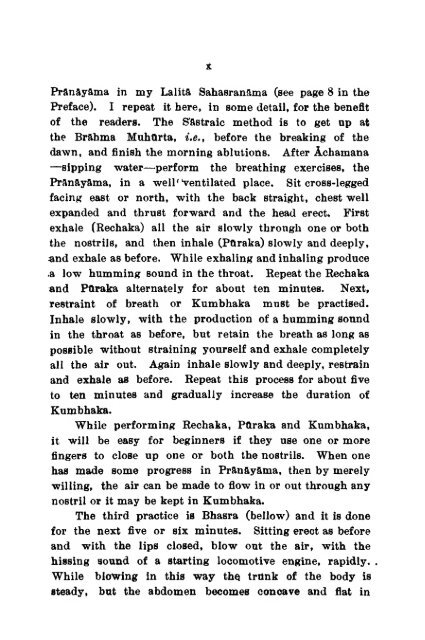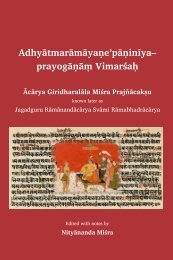Vishnu.Sahasranama.with.the.Bhasya.of.Sankaracharya_text
Vishnu.Sahasranama.with.the.Bhasya.of.Sankaracharya_text
Vishnu.Sahasranama.with.the.Bhasya.of.Sankaracharya_text
Create successful ePaper yourself
Turn your PDF publications into a flip-book with our unique Google optimized e-Paper software.
Pranayama in my Lalita SahasranSma (see page 8 in <strong>the</strong><br />
Preface). I repeat it here, in some detail, for <strong>the</strong> benefit<br />
<strong>of</strong> <strong>the</strong> readers. The Sttstraic method is to get up at<br />
<strong>the</strong> Brahma Muhttrta, i.e., before <strong>the</strong> breaking <strong>of</strong> <strong>the</strong><br />
dawn, and finish <strong>the</strong> morning ablutions. After Achamana<br />
—sipping water—perform <strong>the</strong> breathing exercises, <strong>the</strong><br />
Pranayama, in a well' Ventilated place. Sit cross-legged<br />
facing east or north, <strong>with</strong> <strong>the</strong> back straight, chest well<br />
expanded and thrust forward and <strong>the</strong> head erect. First<br />
exhale (Rechaka) all <strong>the</strong> air slowly through one or both<br />
<strong>the</strong> nostrils, and <strong>the</strong>n inhale (Paraka) slowly and deeply,<br />
and exhale as before. While exhaling and inhaling produce<br />
.a low humming sound in <strong>the</strong> throat. Repeat <strong>the</strong> Rechaka<br />
and Paraka alternately for about ten minutes. Next,<br />
restraint <strong>of</strong> breath or Kumbhaka must be practised.<br />
Inhale slowly, <strong>with</strong> <strong>the</strong> production <strong>of</strong> a humming sound<br />
in <strong>the</strong> throat as before, but retain <strong>the</strong> breath as long as<br />
possible <strong>with</strong>out straining yourself and exhale completely<br />
all <strong>the</strong> air out. Again inhale slowly and deeply, restrain<br />
and exhale as before. Repeat this process for about five<br />
to ten minutes and gradually increase <strong>the</strong> duration <strong>of</strong><br />
Kumbhaka.<br />
While performing Rechaka, Paraka and Kumbhaka,<br />
it will be easy for beginners if <strong>the</strong>y use one or more<br />
fingers to close up one or both <strong>the</strong> nostrils. When one<br />
has made some progress in Pranayama, <strong>the</strong>n by merely<br />
willing, <strong>the</strong> air can be made to flow in or out through any<br />
nostril or it may be kept in Kumbhaka.<br />
The third practice is Bhasra (bellow) and it is done<br />
for <strong>the</strong> next five or six minutes. Sitting erect as before<br />
and <strong>with</strong> <strong>the</strong> lips closed, blow out <strong>the</strong> air, <strong>with</strong> <strong>the</strong><br />
hissing sound <strong>of</strong> a starting locomotive engine, rapidly. .<br />
While blowing in this way <strong>the</strong>. trunk <strong>of</strong> <strong>the</strong> body is<br />
steady, but <strong>the</strong> abdomen becomes concave and flat in



